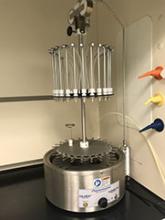Case Studies, Environmental, PFAS
/ Organomation
At the Harvard School of Engineering and Applied Sciences, the Sunderland lab is conducting analysis of environmental samples. Specifically, they are analyzing trace metals and PFAS in water, soil, sediment and biological tissues. Their laboratory is made up of different instruments to aid in their research and analysis.
“Our research goal is to better understand how chemicals released by human activity interact with natural ecosystems and affect living systems. A main innovation of our group’s work is to quantitatively analyze the entire exposure pathway for aquatic pollutants to identify key processes that have a large influence on their accumulation in biota. Our research approach combines environmental measurements with statistical and mechanistic simulation models to project chemical levels over space and time. This integrated approach allows us to better understand how global change (both chemical releases and climate change) will affect human and ecological health risks associated with environmental toxicants.”
They make use of Organomation’s 24 position N-EVAP nitrogen blowdown evaporator to help in their analysis. Our nitrogen evaporators utilize adjustable nitrogen blowdown technology allowing for full control of nitrogen flow to samples, with no wasted nitrogen gas. We combine this technology with uniform heat applied efficiently through either water or dry baths. This technique saves labs money by simultaneously maximizing solvent evaporation volume and rate.
Within their extensive Publications section, the laboratory presents an immense amount of research with a number of studies dedicated to PFAS.
Examples include the study titled "Isolating the AFFF Signature in Coastal Watersheds" published in Environmental Science & Technology investigates the impact of aqueous film-forming foams (AFFF) on coastal watersheds. AFFF, widely used in firefighting, is a significant source of per- and polyfluoroalkyl substances (PFAS), persistent and potentially harmful environmental pollutants.
Research Objectives:
- Identify AFFF-Derived PFAS: Distinguish PFAS originating from AFFF in complex coastal watershed environments.
- Assess Environmental Impact: Evaluate how AFFF contamination affects water quality and ecosystem health.
Methods:
1. Sample Collection and Preparation:
a. Water Sample Collection: Samples were collected from various points within coastal watersheds known or suspected to be impacted by AFFF usage. This included sites near military bases and airports where AFFF is frequently used.
b. Sample Concentration: The collected water samples were subjected to solid-phase extraction (SPE) to isolate PFAS. The Organomation N-EVAP nitrogen evaporator was then used to concentrate these extracts, reducing the sample volume while preserving the analytes, thereby increasing the detection sensitivity.
2. Advanced Chromatographic Techniques:
a. Liquid Chromatography-Tandem Mass Spectrometry (LC-MS/MS): The concentrated samples were analyzed using LC-MS/MS, a powerful technique that separates individual PFAS compounds based on their mass and charge. This method allowed for the identification and quantification of various PFAS, providing detailed insights into the specific compounds present in the samples.
b. Column Selection: Specific columns were chosen to optimize the separation of PFAS compounds, accounting for the wide range of chemical properties within the PFAS family.
3. Isotopic Analysis:
a. Isotope Ratio Mass Spectrometry (IRMS): To trace the sources of PFAS, IRMS was used to measure the isotopic ratios of elements within the compounds. AFFF-related PFAS often have unique isotopic signatures compared to PFAS from other sources. This analysis helps in pinpointing AFFF as the origin of contamination.
4. Data Analysis and Source Apportionment:
a. Statistical Modeling: Chemists applied multivariate statistical techniques to the data to differentiate between PFAS from AFFF and other sources. This included principal component analysis (PCA) and hierarchical clustering, which helped to visualize and group similar PFAS signatures.
b. Source Identification: The unique chemical and isotopic profiles obtained from the analysis were used to create a "fingerprint" for AFFF-derived PFAS. This fingerprint was crucial for identifying the presence and extent of AFFF contamination within the broader PFAS spectrum in the environment.
5. Quality Control & Validation:
a. Method Validation: Rigorous quality control measures were implemented, including the use of spiked samples and method blanks to validate the accuracy and precision of the analytical methods.
b. Repeatability: Multiple samples from each site were analyzed to ensure the repeatability and reliability of the results.
Findings:
- Distinct AFFF Signature: The study successfully identified a distinct chemical and isotopic signature of AFFF-derived PFAS in coastal watersheds. This signature helps in tracking AFFF pollution and differentiating it from other PFAS sources.
- Environmental Persistence: AFFF-related PFAS were found to be highly persistent in the environment, suggesting long-term impacts on water quality and marine ecosystems.
- Spatial Distribution: The research mapped the distribution of PFAS in the studied coastal regions, highlighting areas of significant contamination.
Implications:
- Regulatory Insight: The findings provide critical data for regulatory agencies to formulate guidelines and policies for managing PFAS contamination from firefighting foams.
- Environmental Management: The ability to isolate AFFF-derived PFAS enhances the effectiveness of environmental monitoring and remediation efforts.
This research underscores the importance of advanced analytical techniques in understanding and managing PFAS pollution in vulnerable coastal ecosystems.
→ Next: Nitrogen Dryer Increases LC-MS Sample Prep Productivity by 400%
→ Next: PFAS Sample Preparation: The Definitive Guide
Last updated: June 26, 2024
